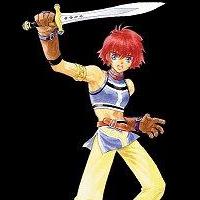
Reid Hershel
CBUB Wins: 0
CBUB Losses: 0
CBUB Ties: 0
Win Percentage: 0%
Added by: Rei-Kai
is a Japanese PlayStation action role-playing video game released by Namco on November 30, 2000, selling 873,000 copies and later ported to the PlayStation Portable on March 3, 2005, selling 398,000 copies . Tales of Eternia's characteristic genre name is . Eternia is a 2D anime-style RPG with an original real-time battle system taken from its predecessors, Tales of Phantasia and Tales of Destiny. It is the third "Mothership Title" of the Tales RPG series; the Linear Motion Battle System, as well as various other aspects from previous Tales titles, still feature prominently.
Its North American release was titled Tales of Destiny II to avoid trademark infringement on the name Eternia, owned by Mattel in North America for the Masters of the Universe toyline. The naming choice later caused some confusion after the release of the PlayStation 2 game known as Tales of Destiny 2, a genuine sequel to Tales of Destiny taking place in the same fictional world. Tales of Eternia is not directly related to Tales of Destiny, except for a few brief character cameos that are typical of all Tales series games after Tales of Phantasia.
Both the North American and Japanese releases of the game feature an anime introductory video; the Japanese version has an accompanying song called flying by Garnet Crow. The game inspired Tales of Eternia, a 13 episode anime series co-produced by Production I.G, which is loosely based on the game. The series focuses on the four main characters while introducing a few new faces in a subplot unrelated to the game's actual plot. All 13 episodes of the series were animated in early 2001.
Following the precedent set by previous Tales games and the CRPG genre in general, Tales of Eternia has four major game modes: the 3D world map, 2D town/dungeon maps, the battle screen, and the menu screen. The overworld map is used to navigate from one location to another in the game's fictional world; the individual locations on the overwold map are represented with 2D backgrounds and sprites. Cities and towns, which are extensively populated with NPCs, are valuable sources of plot progression and background information. Additionally, city merchants will exchange Gald, the in-game currency, for items or equipment that can be vital to completing the game. Random encounter-based combat is resolved on the battle screen using the Linear Motion Battle System, a hybrid that combines fighting game and traditional role-playing game elements. The menu screen is where the player organizes and uses items, creates new magic spells, develops battle strategies, changes character equipment, and views character statistics. Selected features from the menu screen, such as item use and AI settings, are also available in battle. The player can also learn recipes throughout the game, using them to cook status-enhancing or healing food out of combat.
CBUB Match Record:
No Regular Play Records Available
No Fantasy Draft Records Available
